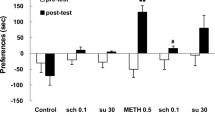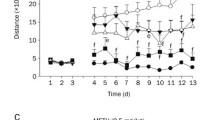Abstract
The present study examined effects of selective antagonists of D-1 and D-2 dopamine receptors on the development of behavioral sensitization produced by repeated methamphetamine (MAP) administration. Male Sprague-Dawley rats were divided into four groups. Each group received a daily injection of saline (control group), 4 mg/kg MAP (MAP group), 1 mg/kg YM-09151-2 plus 4 mg/kg MAP (YM+MAP group) or 0.5 mg/kg SCH 23390 plus 4 mg/kg MAP (SCH+MAP group) for 14 days. During daily injection for 14 days, the MAP group exhibited a progressive augmentation in locomotor and stereotyped behavior, whereas the progression of such behaviors in the YM+MAP and SCH+MAP group was completely prevented. After an abstinence period of 7 days, all groups received a challenge of 2 mg/kg MAP. The MAP challenge reproduced hyperlocomotion and intense stereotyped behavior only in the MAP group. However, neither the YM+MAP group nor the SCH+MAP group showed sterotypy. The manner in which both groups showed only hyperlocomotion was similar to that observed in the control group. These results indicate that both selective D-1 antagonists and selective D-2 antagonists not only reverse MAP-induced motor effects at each injection but also prevent the development of behavioral sensitization induced by repeated MAP administration.
Similar content being viewed by others
References
Akiyama K, Sato M, Otsuki S (1982) Increased 3H-spiperone binding sites in mesolimbic area related to methamphetamine-induced behavioral hypersensitivity. Biol Psychiatry 17:223–231
Angrist B, Lee HK, Gershon S (1974) The antagonism of amphetamine induced symptomatology by a neuroleptic. Am J Psychiatry 131:817–819
Billard W, Ruperto V, Crosby G, Iorio LC, Barnett A (1984) Characterization of the binding of 3H-SCH 23390, a selective D-1 receptor antagonist ligand, in rat striatum. Life Sci 35:1885–1893
Christensen AV, Arnt J, Hyttel J, Larsen J-J, Svendsen O (1984) Pharmacological effects of a specific dopamine D-1 antagonist SCH 23390 in comparison with neuroleptics. Life Sci 34:1529–1540
Creese I, Chen A (1985) Selective D1 dopamine receptor increase following chronic treatment with SCH 23390 Eur J Pharmacol 109:127–128
Ellinwood EH, Sudilovski A, Nelson LJ (1973) Evolving behavior in the clinical and experimental amphetamine (model) psychosis. Am J Psychiatry 130:1088–1093
Espelin DE, Done HK (1968) Amphetamine poisoning: effectiveness of chlorpromazine. N Engl J Med 278:1361–1365
Hyttel J (1983) SCH 23390—The first selective dopamine D-1 antagonist. Eur J Pharmacol 91:153–154
Ichikawa J, Koyama T, Mikuni M, Yamashita I (1986) Effect of methampetamine on presynaptic regulation of monoaminergic neural transmission: in vivo brain dialysis. Bull Jpn Neurochem Soc 25:280–282 (in Japanese)
Iorio LC, Barnett A, Leitz FH, Houser VP, Korduba CA (1983) SCH 23390, a potential benzazepine antipsychotic with unique interaction on dopaminergic systems. J Pharmacol Exp Ther 226:462–468
Jenner P, Marsden CD (1981) Substituted benzamide drugs as selective neuroleptic agents. Neuropharmacology 20:1285–1293
Kashihara K, Fujiwara Y, Sato M (1984) Continuous suppression of methamphetamine-induced supersensitivity by chronic haloperidol administration. Psychiatr Neurol Jpn 86:928–932 (in Japanese)
Kasiwabara K, Akiyama T, Sato M, Otsuki S (1984) Effect of haloperidol, sulpiride and caeruletide on methamphetamine-induced abnormal behaviors in animals. Jpn J Neuropsychopharmacol 6:181–189 (in Japanese)
Kazahaya Y, Akimoto K, Otsuki S (1989) Subchronic methamphetamine treatment enhances methamphetamine-or cocaineinduced dopamine efflux in vivo. Biol Psychiatry (in press)
Mailman RB, Schulz DW, Lewis MH, Staples L, Rollema H, Dehaven DL (1984) SCH 23390: a selective D-1 dopamine antagonist with potent D-2 behavioral actions. Eur J Pharmacol 101:159–160
Nelson L, Ellison G (1978) Enhanced stereotypies after repeated injections but not continuous amphetamines. Neuropharmacology 17:1081–1084
Nishikawa T, Mataga N, Takashima M, Toru M (1983) Behavioral sensitization and relative hyperresponsiveness of striatal and limbic dopaminergic neurons after repeated methamphetamine treatment Eur J Pharmacol 88:190–203
Niznik HB, Grigoriadis DE, Pri-Bar I, Buchman O, Seeman P (1985) Dopamine D2 receptor selectively labeled by a benzamide neuroleptic: [3H]-YM-09151-2. Naunyn-Schmiedeberg's Arch Pharmacol 329:333–343
Peroutka SJ, Snyder SH (1980) Relationship of neuroleptic drug effects at brain dopamine, serotonin, α-adrenergic, and histamine receptors to clinical potency. Am J Psychiatry 137:1518–1522
Porceddu ML, Ongini E, Biggio G (1985) [3H]SCH 23390 binding sites increase after chronic blockade of D-1 dopamine receptors. Eur J Pharmacol 118:367–370
Pugh MT, O'Boyle KM, Molloy AG, Waddington JL (1985) Effects of the putative D-1 antagonist SCH 23390 on stereotyped behaviour induced by the D-2 agonist RU 24213. Psychopharmacology 87:308–312
Robinson TE, Becker JB (1986) Enduring changes in brain and behavior produced by chronic amphetamine administration: a review and evaluation of animal models of amphetamine psychosis. Brain Res Rev 11:157–198
Sato M (1979) An experimental study of onset and relapse mechanisms of the chronic methamphetamine psychosis. Psychiatr Neurol Jpn 81:21–32 (in Japanese)
Sato M, Chen C-C, Akiyama K, Otsuki S (1983) Acute exacerbation of paranoid psychotic state after long-term abstinence in patients with previous methamphetamine psychosis. Biol Psychiatry 18:429–440
Schulz DW, Wyricke SD, Mailman RB (1985) [3H]SCH 23390 has the characteristics of a dopamine receptor ligand in the central neurons system. Eur J Pharmacol 106:211–212
Segal DS, Mandell AJ (1974) Long-term administration of d-amphetamine: progressive augmentation of motor activity and stereotypy. Pharmacol Biochem Behav 2:249–255
Segal DS, Janowsky DS (1978) Psychostimulant-induced behavioral effects: possible models of schizophrenia. In: Lipton MA, DiMascio A, Killam KF (eds) Psychopharmacology: a generation of progress. Raven Press, New York, pp 1113–1123
Shuster L, Yu G, Bates A (1977) Sensitization to cocaine stimulation in mice. Psychopharmacology 52:185–190
Sonsalla PK, Gibb JW, Hanson GR (1986) Roles of D1 and D2 dopamine receptor subtypes in mediating the methamphetamine-induced changes in monoamine systems. J Pharmacol Exp Ther 238:932–937
Terai M, Usuda S, Kuroiwa I, Noshiro O, Maeno H (1983) Selective binding of YM-09151-2, a new potent neuroleptic, to D2-dopaminergic receptors. Upn J Pharmacol 33:749–755
Author information
Authors and Affiliations
Rights and permissions
About this article
Cite this article
Ujike, H., Onoue, T., Akiyama, K. et al. Effects of selective D-1 and D-2 dopamine antagonists on development of methamphetamine-induced behavioral sensitization. Psychopharmacology 98, 89–92 (1989). https://doi.org/10.1007/BF00442011
Received:
Accepted:
Issue Date:
DOI: https://doi.org/10.1007/BF00442011




